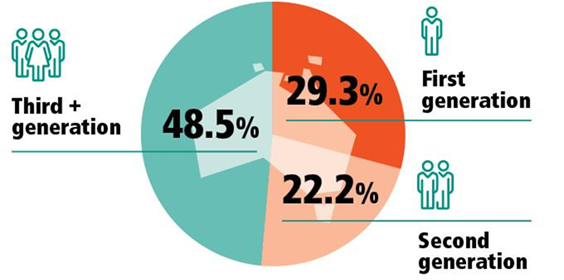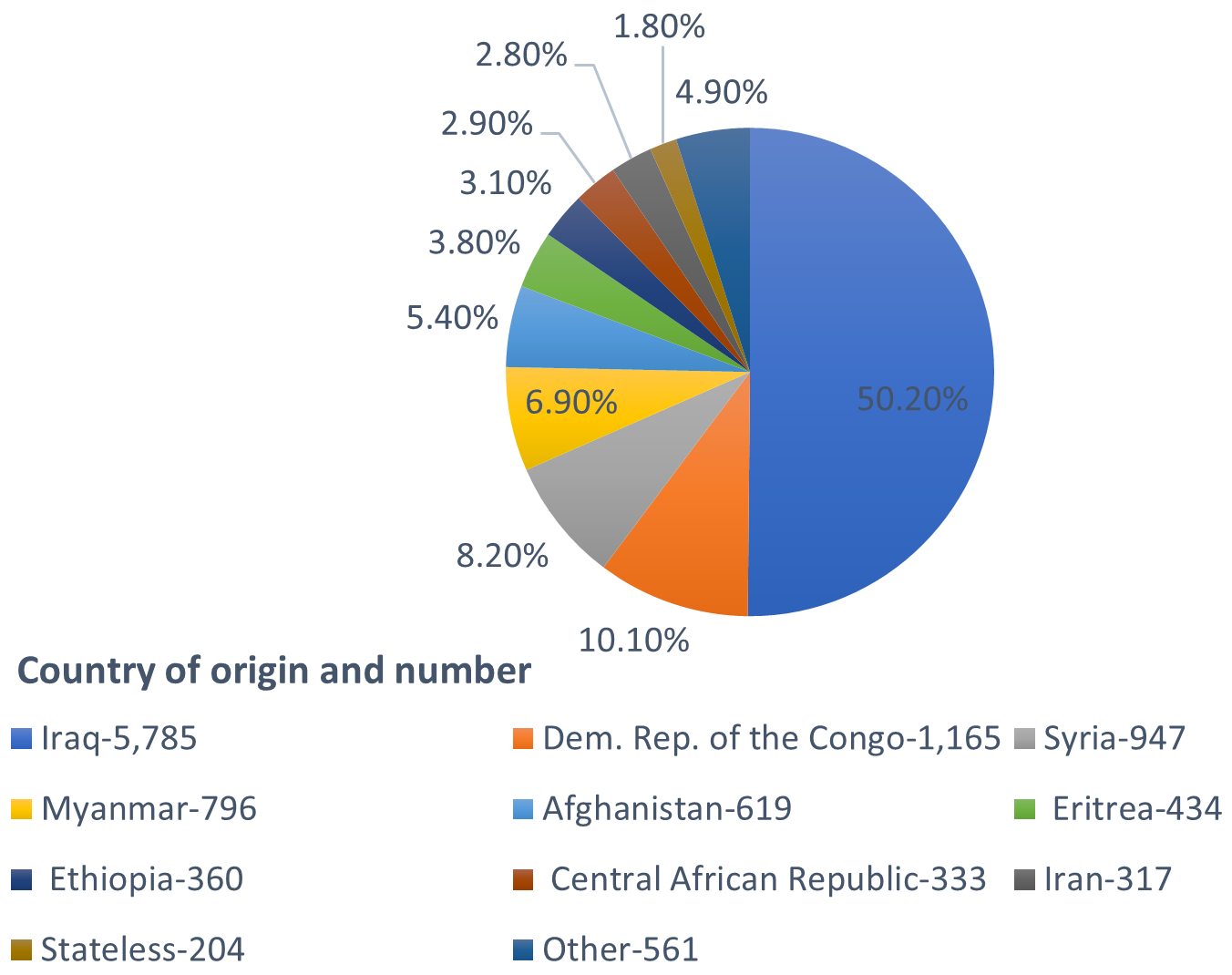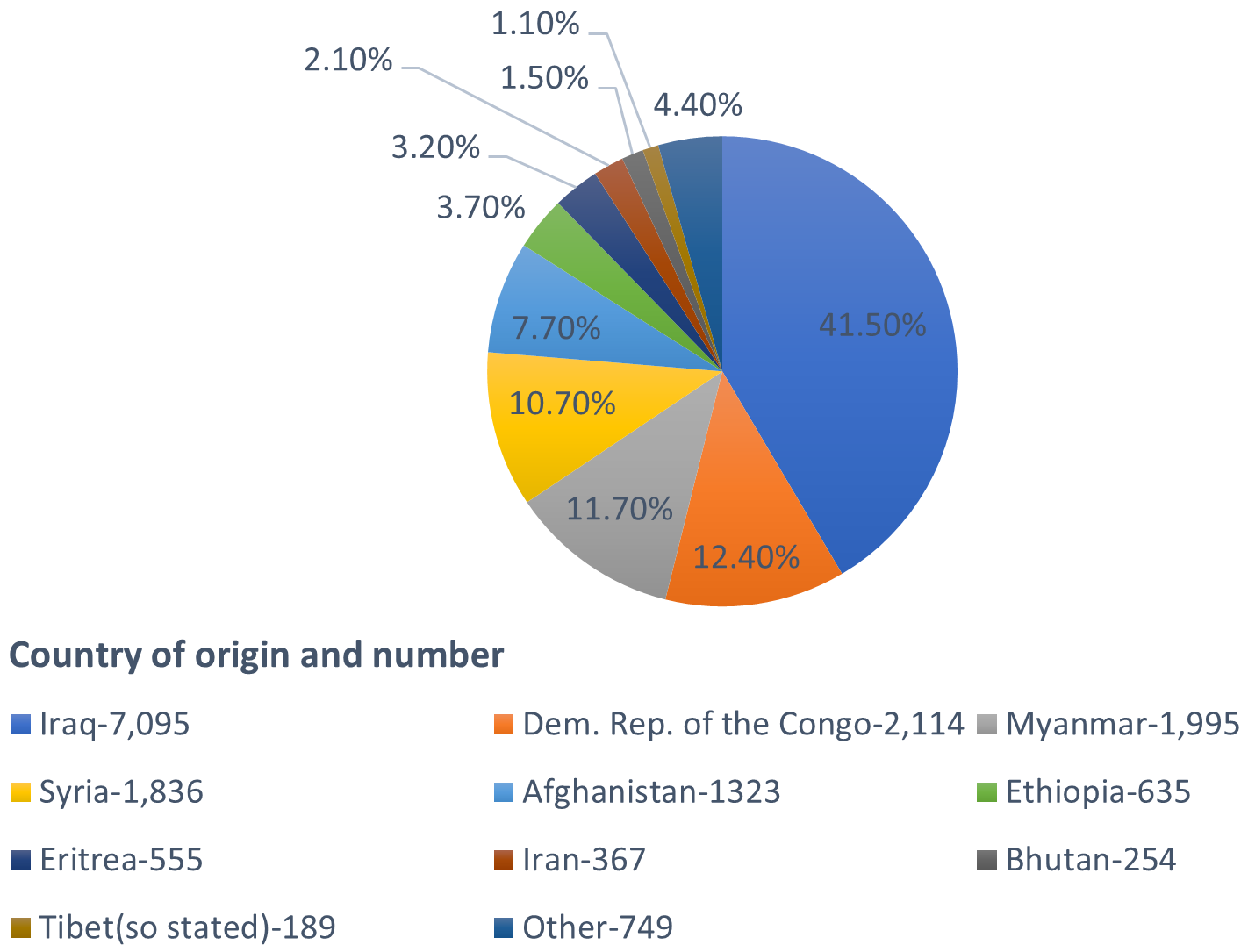Australians come from over 200 countries according to the 2021 Census. Each of these groups has its own cultural diversity as a result of history, regional differences, internal and external population movements, as well as variations related to factors such as class, gender, intermarriage and urban and rural environments.
Aboriginal and Torres Strait Islander peoples
The Aboriginal and Torres Strait Islander community of Australia is diverse and comprised of a wide range of cultural groups speaking many different languages.
The following data is derived from the 2021 Census:
- About 812,728 people or 3.2 % of the Australian population identified as being Aboriginal, Torres Strait Islander or both. Between the 2016 and 2021 Censuses, the Aboriginal and Torres Strait Islander population increased by 25% or 163,557 people.
- Of this group, 742,882 people stated they were of Aboriginal origin only, 33,765 people reported to be of Torres Strait Islander origin only whilst 36,083 people reported to be of both origins.
- The States/Territories with the highest Aboriginal and Torres Strait Islander populations are New South Wales (278,043 or 34% of the total Aboriginal and Torres Strait Islander population of Australia), Queensland (237,303 or 29%), Western Australia (88,693 or 11%) and Victoria (65,646 or 8%).
- Around 26% of people in the Northern Territory are Aboriginal or Torres Strait Islander peoples. In all other States/Territories [2] , except Tasmania (5.4%), Aboriginal and Torres Strait Islander peoples comprise less than 5% of the total state population.
- Most Torres Strait Islander people (64.5%) live in Queensland while 15% live in New South Wales and 6% live in Victoria.
| State/Territory | Aboriginal | Torres Strait Islander | Both Aboriginal and Torres Strait Islander | Proportion of total population of State/Territory |
|---|---|---|---|---|
| New South Wales | 267,067 | 5,127 | 5,844 | 3.44 |
| Victoria | 61,865 | 2,083 | 1,692 | 1.01 |
| Queensland | 193,405 | 21,772 | 22,122 | 4.60 |
| South Australia | 40,592 | 994 | 967 | 2.39 |
| Western Australia | 85,004 | 1,625 | 2,068 | 3.33 |
| Tasmania | 27,738 | 1,225 | 1,229 | 5.41 |
| Northern Territory | 58,566 | 692 | 1,852 | 26.27 |
| Australian Capital Territory | 8.425 | 230 | 300 | 1.97 |
| Other Territories | 212 | 6 | 6 | 4.68 |
| Australia | 742,882 | 33,765 | 36,083 |
Source: Australian Bureau of Statistics 2021, Customised tables
Overseas born
The birthplace of overseas-born residents gives some indication of the diversity of ethnicity of a population. When Australian born residents with one or both parents born overseas are combined with overseas born, a fuller picture of cultural diversity emerges.
The following data is derived from the 2021 Census:
- Around 28% of Australians were born overseas and 66.9% were born in Australia. [3]
- Around 20% of the population were born in non-English speaking countries compared to 8% who were born in English speaking countries [4] other than Australia.
- The proportion of Australian residents who were born overseas (first generation) or have a parent who was born overseas (second generation) has increased to above 50 per cent (51.5 per cent).
- The largest groups of people born overseas comprised people born in the United Kingdom [5] (1,108,416 people or about 5% of the population) followed by India (673, 352 people or about 3%). China [6] (549, 618 people or about 2%), then New Zealand (530,492 people or about 2%) and India (455,400 people or about 2%). People born in the Philippines and Vietnam represented just over 1% of the population at 1.15% and 1.01% respectively. Other overseas born groups each comprised less than 1% of the population.
- The State with the largest number of overseas born people was New South Wales (2,367,028 people) followed by Victoria (1,951,828 people) and Queensland (1,170,433 people). Western Australia had the highest proportion of overseas born residents (34%) excluding Other Territories [7] which reported 42% in 2021.
| Country | Persons | % Total population |
|---|---|---|
| Australia | 17,019,815 | 66.9 |
| England | 927,490 | 3.6 |
| India | 673,352 | 2.6 |
| China (excludes SARs and Taiwan) | 549,618 | 2.2 |
| New Zealand | 530,492 | 2.1 |
| Philippines | 293,892 | 1.2 |
| Vietnam | 257,997 | 1.0 |
| South Africa | 189,207 | 0.7 |
| Malaysia | 165,616 | 0.7 |
| Italy | 163,326 | 0.6 |
| Sri Lanka | 131,904 | 0.5 |
| Nepal | 122,506 | 0.5 |
| Scotland | 118,496 | 0.5 |
| Korea, Republic of (South) | 102,092 | 0.4 |
| United States of America | 101,309 | 0.4 |
| Germany | 101,255 | 0.4 |
| Hong Kong (SAR of China) | 100,148 | 0.4 |
| Iraq | 92,922 | 0.4 |
| Greece | 92,314 | 0.4 |
| Pakistan | 89,633 | 0.4 |
| Lebanon | 87,340 | 0.3 |
| Indonesia | 87,075 | 0.3 |
| Thailand | 83,779 | 0.3 |
| Ireland | 80,927 | 0.3 |
| Iran | 70,899 | 0.3 |
| Fiji | 68,947 | 0.3 |
| Netherlands | 66,481 | 0.3 |
| Singapore | 61,056 | 0.2 |
| Afghanistan | 59,797 | 0.2 |
| Bangladesh | 51,491 | 0.2 |
Source: Australian Bureau of Statistics 2021, Customised tables
| New South Wales | Victoria | Queensland | South Australia | Western Australia | Tasmania | Northern Territory | Australian Capital Territory | Other Territories |
|---|---|---|---|---|---|---|---|---|
| China (excludes SARs and Taiwan) | India | New Zealand | England | England | England | Philippines | India | Norfolk Island |
| England | England | England | India | New Zealand | China (excludes SARs and Taiwan) | England | England | New Zealand |
| India | China (excludes SARs and Taiwan) | India | China (excludes SARs and Taiwan) | India | Nepal | India | China (excludes SARs and Taiwan) | Malyasia |
| New Zealand | New Zealand | China (excludes SARs and Taiwan) | Vietnam | South Africa | India | New Zealand | Nepal | England |
| Philippines | Vietnam | Philippines | Italy | Philippines | New Zealand | Nepal | New Zealand | Philippines |
| Vietnam | Philippines | South Africa | Philippines | Malaysia | Philippines | China (excludes SARs and Taiwan) | Philippines | Singapore |
| Nepal | Sri Lanka | Vietnam | New Zealand | China (excludes SARs and Taiwan) | Scotland | Indonesia | Vietnam | Fiji |
| Lebanon | Italy | Scotland | Scotland | Scotland | Netherlands | Vietnam | United States of America | Sudan |
| Iraq | Malaysia | Germany | Germany | Italy | South Africa | Sri Lanka | Sri Lanka | India |
| Korea, Republic of (South) | Greece | United States of America | Malaysia | Ireland | Germany | United States of America | Pakistan | United States of America |
Source: Australian Bureau of Statistics 2021, Customised tables
Ancestry
A person’s ancestry, when used in conjunction with the person’s birthplace, language, religion and birthplace of their parents, provides a good indication of their ethnic background. This is particularly useful for identifying distinct cultural groups such as Maoris and South Sea Islanders and groups which are spread across countries such as Kurds or Indians. In the 2021 Census, respondents were asked to mark their ancestries back as far as two generations. Respondents were asked to report at least one ancestry, but no more than two.
The following data is derived from the 2021 Census:
- About 46% of respondents indicated that both parents were born in Australia.
- About 48% of respondents indicated that at least one of their parents was born overseas.
- About 18% of first responses to the ancestry question indicated that they were of Australian ancestry.
- The most common first response ancestries other than Australian identified by respondents were, English (8,251,447), Irish (1,292,913), Chinese (1,283,364), Scottish (895,058), Italian (820,715), Australian Aboriginal (720,165) and Indian (678,417). Other common ancestries identified were German (433,756), Filipino (315,916), Greek (293,559), Vietnamese (273,579), and Lebanese (180,722).
| Ancestry (1st Response) | Both parents born overseas | Father only born overseas | Mother only born overseas | Both parents born in Australia | Not stated – birthplace for either or both parents not stated | Total |
|---|---|---|---|---|---|---|
| English | 1,813,759 | 741,426 | 562,591 | 5,057,707 | 75,956 | 8,251,447 |
| Australian | 210,308 | 392,221 | 334,854 | 3,689,587 | 52,199 | 4,679,172 |
| Irish | 239,150 | 97,246 | 66,587 | 881,283 | 8,655 | 1,292,913 |
| Chinese | 1,200,378 | 17,367 | 30,925 | 27,755 | 6,937 | 1,283,364 |
| Scottish | 211,508 | 95,828 | 71,259 | 510,166 | 6,302 | 895,058 |
| Italian | 411,573 | 91,152 | 38,328 | 274,234 | 5,432 | 820,715 |
| Australian Aboriginal | 5,406 | 32,617 | 17,859 | 653,213 | 11,070 | 720,165 |
| Indian | 669,050 | 3,466 | 2,730 | 1,742 | 1,430 | 678,417 |
| German | 171,261 | 34,531 | 25,200 | 198,626 | 4,134 | 433,756 |
| Filipino | 306,440 | 2,119 | 4,138 | 1,626 | 1,587 | 315,916 |
| Greek | 200,400 | 23,036 | 12,049 | 56,036 | 2,039 | 293,559 |
| Vietnamese | 264,784 | 2,360 | 2,890 | 2,146 | 1,401 | 273,579 |
| Lebanese | 130,804 | 20,251 | 9,837 | 18,938 | 894 | 180,722 |
| Dutch | 116,120 | 7,925 | 4,483 | 15,624 | 1,146 | 145,302 |
| Nepalese | 128,981 | 65 | 117 | 38 | 477 | 129,676 |
| Korean | 118,206 | 594 | 821 | 1,102 | 405 | 121,132 |
| Polish | 84,968 | 4,459 | 3,092 | 9,339 | 729 | 102,579 |
| Croatian | 76,602 | 5,800 | 3,321 | 11,378 | 843 | 97,943 |
| Maltese | 66,091 | 6,706 | 3,797 | 16,461 | 781 | 93,839 |
| Pakistani | 83,317 | 741 | 427 | 169 | 215 | 84,871 |
| Macedonian | 66,213 | 5,494 | 3,263 | 8,567 | 527 | 84,069 |
| South African | 75,696 | 1,254 | 800 | 614 | 309 | 78,676 |
| Sri Lankan | 70,332 | 935 | 555 | 719 | 287 | 72,830 |
| Serbian | 60,854 | 3,288 | 2,223 | 3,151 | 485 | 70,001 |
| Iranian | 68,376 | 358 | 254 | 134 | 287 | 69,401 |
| Turkish | 57,333 | 4,462 | 2,570 | 3,462 | 382 | 68,205 |
| Maori | 60,662 | 2,775 | 1,967 | 1,244 | 767 | 67,412 |
| New Zealander | 56,589 | 2,420 | 1,673 | 1,331 | 671 | 62,685 |
| Punjabi | 61,195 | 178 | 157 | 42 | 158 | 61,736 |
| Thai | 59,792 | 218 | 866 | 308 | 394 | 61,570 |
| Samoan | 56,148 | 2,075 | 1,230 | 652 | 669 | 60,782 |
| Other | 1,975,529 | 54,128 | 36,561 | 103,252 | 17,525 | 2,187,145 |
| Not stated | 143,752 | 12,982 | 10,471 | 112,954 | 1,304,004 | 1,584,164 |
Source: Australian Bureau of Statistics 2021, Customised tables

The pie chart shows that 29.3 per cent of the people living in Australia were born overseas, 22.2 per cent of people living in Australia who were Australian born have one or both parents born overseas and 48.5 per cent of people living in Australia who were Australian born have both parents born in Australia.
Refugees
The information in this section is sourced from the Australian Government, Department of Home Affairs – Refugee and humanitarian program. Please visit Roads to Refuge for further information and education materials.
Refugees and people seeking residency in Australia for humanitarian reasons make up an important component of Australia’s overall migrant intake. The Humanitarian Program assists people affected by international crises including refugees and other people suffering human rights violations.
Since the end of World War II, over 920,000 refugees and people in humanitarian need have been resettled in Australia including people from Eastern Europe, South East Asia, Central America, the Middle East and Africa.
In 2020 – 2021:
- 5,947 resettlement visas were granted. Australia usually resettles approximately 13,000 refugees per year. This lower number is a result of the pandemic.
- Of the 4,558 visas granted offshore, 45.0 per cent were granted under the Refugee category and 55.0 per cent were granted under the Special Humanitarian Program (SHP). There were 1,389 permanent Protection visas granted.
- 49.5% of offshore visas were granted to people from the Middle East, 34.6% were granted to people from Asia, 11.2% were granted to people from Africa and nearly 5% to persons from the Americas.
Source: Australia’s Offshore Humanitarian Program: 2020-21 (8)

Notes:
- Visas counted include subclass 200 (Refugee), 201 (In–Country Special Humanitarian Program), 202 (Global Special Humanitarian Program), 203 (Emergency Rescue) and 204 (Woman at Risk).
- Statistics for the offshore component up to 2018–19 are based on country of birth. From 2019–20 they are based on citizenship.
- The Country of origin of principal visa applicants is applied to secondary visa applicants.
- Data was extracted from Departmental systems on 05 July 2021.
- The 2016–17 statistics in this table includes visas granted towards the annual offshore resettlement component of the Humanitarian Program, and the additional 12,000 places for people displaced by conflict in Syria and Iraq.


